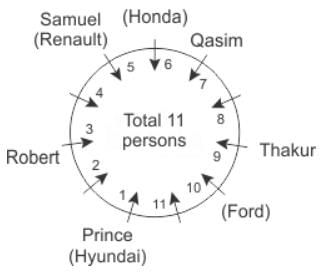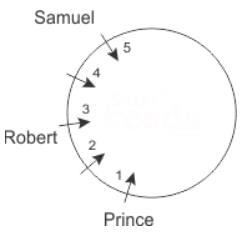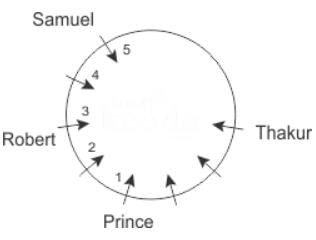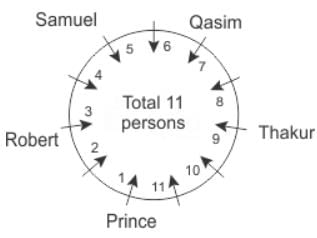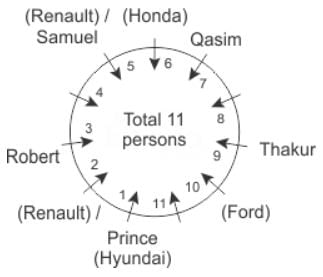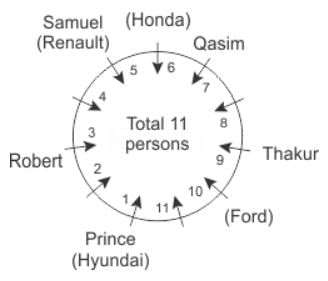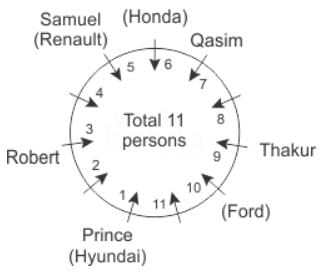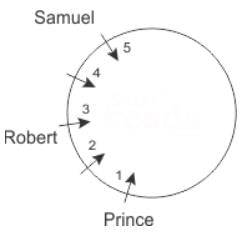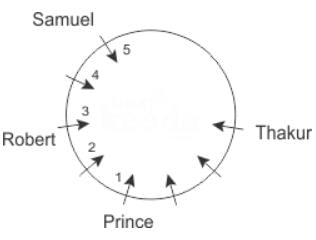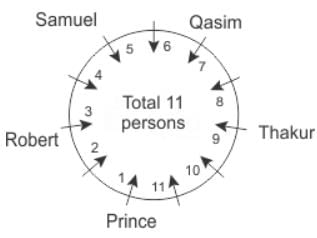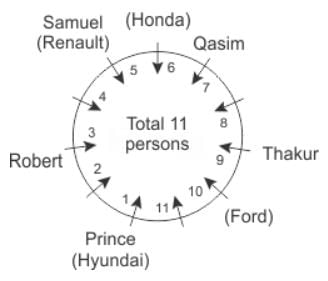EPFO Assistant Prelims Mock Test - 9 - Bank Exams MCQ
30 Questions MCQ Test - EPFO Assistant Prelims Mock Test - 9
P, Q, R and S are four males. P is the eldest in the group but he is not the poorest, R is the richest but not the eldest, Q is elder than S but he is not elder than P or R, P is richer than Q but he is not richer than S. How the four persons can be arranged in decreasing order of their age and money ?
Directions: In the following questions two statements are followed by two conclusions. You have to mark the appropriate answer as per the information given.
Statement : R > M ≥ T ≤ Q = S
Conclusions : I. R > Q, II. Q ≥ M
Conclusions : I. R > Q, II. Q ≥ M
Directions: Read the given information carefully and answer the questions given beside:
Certain number of persons are sitting around a circular table and facing towards the center of the table. Some of them own different cars. No two persons have same car.
Three persons are sitting between Thakur and the one, who owns Renault. Two persons are sitting between Thakur and Prince. Robert is sitting second to the left of Prince. Samuel is sitting second to the left of Robert. Samuel and Thakur are not the immediate neighbors. Qasim is sitting second to the right of Thakur. The one, who owns Ford, is sitting third to the left of Qasim. The one, who owns Hyundai, is sitting second to the left of the one, who owns Ford. Three persons are not sitting between the one, who owns Renault and the one, who owns Honda, when counted from the right of the one, who owns Honda. The one, who sits immediate left of Samuel, owns Honda. Number of persons sitting between Qasim and Prince, when counted from right of Prince is four times as the number of persons sitting between Samuel and Qasim, when counted from left of Samuel.
Q. How many persons are sitting in the circle?
Three persons are sitting between Thakur and the one, who owns Renault. Two persons are sitting between Thakur and Prince. Robert is sitting second to the left of Prince. Samuel is sitting second to the left of Robert. Samuel and Thakur are not the immediate neighbors. Qasim is sitting second to the right of Thakur. The one, who owns Ford, is sitting third to the left of Qasim. The one, who owns Hyundai, is sitting second to the left of the one, who owns Ford. Three persons are not sitting between the one, who owns Renault and the one, who owns Honda, when counted from the right of the one, who owns Honda. The one, who sits immediate left of Samuel, owns Honda. Number of persons sitting between Qasim and Prince, when counted from right of Prince is four times as the number of persons sitting between Samuel and Qasim, when counted from left of Samuel.
Directions: Read the given information carefully and answer the questions given beside:
Certain number of persons are sitting around a circular table and facing towards the center of the table. Some of them own different cars. No two persons have same car.
Three persons are sitting between Thakur and the one, who owns Renault. Two persons are sitting between Thakur and Prince. Robert is sitting second to the left of Prince. Samuel is sitting second to the left of Robert. Samuel and Thakur are not the immediate neighbors. Qasim is sitting second to the right of Thakur. The one, who owns Ford, is sitting third to the left of Qasim. The one, who owns Hyundai, is sitting second to the left of the one, who owns Ford. Three persons are not sitting between the one, who owns Renault and the one, who owns Honda, when counted from the right of the one, who owns Honda. The one, who sits immediate left of Samuel, owns Honda. Number of persons sitting between Qasim and Prince, when counted from right of Prince is four times as the number of persons sitting between Samuel and Qasim, when counted from left of Samuel.
Q. Who sits third to the right of the one, who owns Honda car?
Statements :
I. R's sister J has married T's brother L, who is the only son of his parents.
II. K is the only daughter of L and J.
Q: How is T related to K?
Statements :
I. M is brother of P and T is sister of P.
II. P's mother is married to J's husband who has one son and two daughters.
Q: How is J related to P ?
Statements :
I. Y and Z are children of D who is wife of X.
II. R's sister X is married to Ys father.
Q: How is X related to Y ?
Directions: Study the following information carefully and answer the given questions.
The distance between N and P is 50m and that between Q and R is 40m. Q is to the west of R, which is to the east of N at a distance of 70m. P is to the west or northwest or north or Q.
Q. If Q is to the south of P, what is the distance between P and Q?
Direction: In each question below is given a statement followed by two conclusions numbered I and II. You have to assume everything in the statement to be true, then consider the two conclusions together and decide which of them logically follows beyond a reasonable doubt from the information given in the statement.
Statements: The percentage of the national income shared by the top 10 per cent of households in India is 35.
Conclusions:
- When an economy grows fast, concentration of wealth in certain pockets of population takes place.
- The national income is unevenly distributed in India.
Direction : Study the following question carefully and choose the right answer.
Q: If in a certain code, CORPORATIONS, is written as PROCTAROSNOI, then how is JUDICIAL written in that code?
Direction : Study the following question carefully and choose the right answer.
Q: In a certain code, REFRIGERATOR is coded as ROTAREGIRFER. Which word would be coded as NOITINUMMA?
Statements:
Some people are buyers.
No buyer is market.
Some markets are not malls.
Conclusions:
I.Some malls are buyers.
II.Some buyers are not malls.
If 8 boys and 12 women can do a piece of work in 25 days, in how many days can the work bedone by 6 boys and 11 women working together?
A can do a piece of work in 20 days. He works at it for 5 days and then B finishes it in 10 moredays. In how many days will A and B together finish the work?
What is the volume (in cubic cm) of given figure?
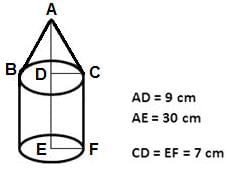
In an election contested by two parties A and B, party A secured 25 percent of the total votes more than Party B. If party B gets 15000 votes. By how much votes does party B loses the election?
P and Q are two different mouth fresheners, prepared by mixing Supari and Saunf in the ratios 9 : 4 and 9 : 17, respectively. If equal quantities of the P and Q mouth fresheners are mixed to form a third kind of mouth freshener R, find the ratio of Saunf and Supari in R.
Practice Quiz or MCQ (Multiple Choice Questions) with solutions are available for Practice, which would help you prepare for "Line Charts" under LR and DI. You can practice these practice quizzes as per your speed and improvise the topic. The same topic is covered under various competitive examinations like - CAT, GMAT, Bank PO, SSC and other competitive examinations.
Q.
The following line graph gives the ratio of the amounts of imports by a company to the amount of exports from that company over the period from 1995 to 2001.
If the imports in 1998 was Rs. 250 crores and the total exports in the years 1998 and 1999 together was Rs. 500 crores, then the imports in 1999 was ?
Directions: Study the pie-chart and table given below and answer the questions.
Details of the percentage of employees working in various departments in an organization and number of males among them.
Total number of employees = 800.

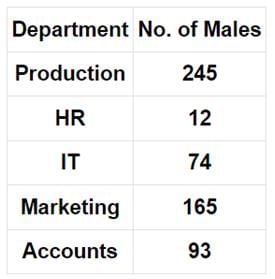
Q. The respective ratio between the number of females working in HR department to the total number of employees working in the HR department is:
Directions: Study the pie-chart and table given below and answer the questions.
Details of the percentage of employees working in various departments in an organization and number of males among them.
Total number of employees = 800.

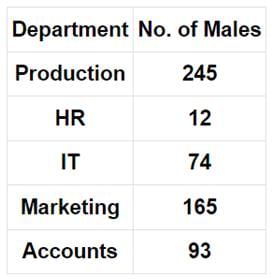
Q. The percentage of females working in IT department to the total number of employees working in the organization is:
A certain league has four divisions. The respective divisions had 9, 10, 11, and 12 teams qualify for the playoffs. Each division held its own double-elimination tournament -- where a team is eliminated from the tournament upon losing two games -- in order to determine its champion. The four division champions then played in a single-elimination tournament -- where a team is eliminated upon losing one game -- in order to determine the overall league champion. Assuming that there were no ties and no forfeits, what is the maximum number of games that could have been played in order to determine the overall league champion?
60 kg of a certain variety of Sugar at Rs.32 per kg is mixed with 48 kg of another variety of sugar and the mixture is sold at the average price of Rs.28 per kg. If there be no profit or no loss due to the new selling price, then what is the price of second variety of Sugar?
Six litre of milk was taken out from a vessel and is then filled with water. This operation is performed two more times. The ratio of the quantity of milk now left in vessel to that of the water is 8 : 27. How much is the quantity of the milk contained by the vessel originally?
In a horse race there were 18 horses numbered 1-18. The probability that horse 1 would win is 1/6, that 2 would win is 1/10 and that 3 would win is 1/8.
Assuming that a tie is impossible, find the chance that one of the three will win.
We can't hardly believe that the / situation is so serious as / to justify such precautions / as you have taken.
The Moon may be the best place / to look for aliens as their / footprints on their surface would / last far longer than radio signals.
Directions: Identify the words that are similar in meaning to the phrase in underline. If none of option conveys the correct meaning, mark (E) as your answer. The options do not necessarily need to be grammatically correct.
Economic growth is a crucial measure of a country's success and thus the data put out by the Indian government needs to be above board, allowing investors and voters to make well-informed choices.
Practice Quiz or MCQ (Multiple Choice Questions) with solutions are available for Practice, which would help you prepare for "Closet Test " under Verbal Aptitude. You can practice these practice quizzes as per your speed and improvise the topic. The same topic is covered under various competitive examinations like - CAT, GMAT, Bank PO, SSC and other competitive examinations.
Instruction for the Next Five questions are given below:
Today most businessmen are very worried. To begin with, they are not used to competition.In the past they sold whatever ...(1)... produced at whatever prices they chose. But ...(2)... increasing competition, customers began to ...(3)... and choose. Imports suddenly became ...(4)... available and that too at cheaper ...(5)...
What will come in Option one?
The grocer
P: did not listen to the protests of customer
Q: who was in the habit of weighing less
R: whom he had cheated
S: with great audacity
The Proper sequence should be:



